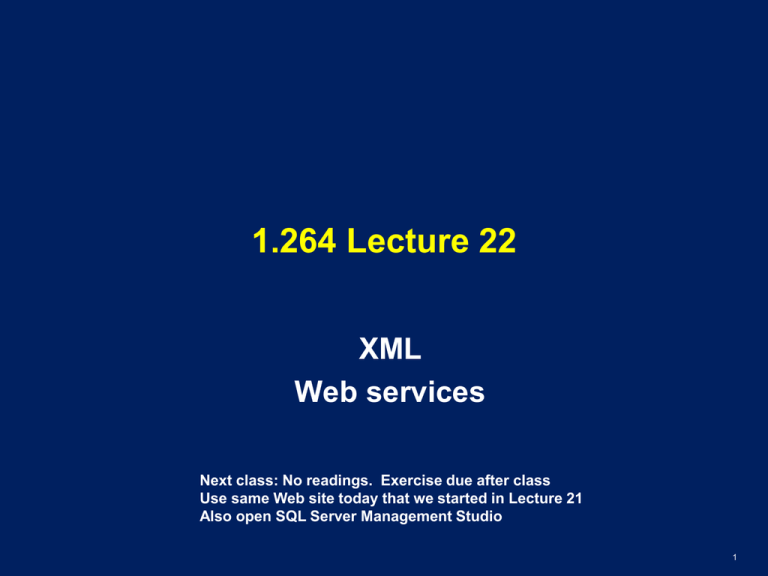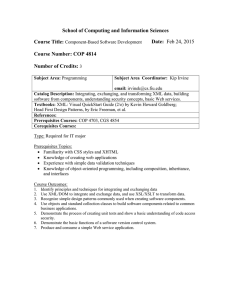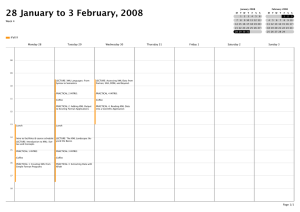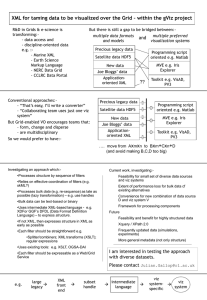1.264 Lecture 22 XML Web services
advertisement

1.264 Lecture 22
XML
Web services
Next class: No readings. Exercise due after class
Use same Web site today that we started in Lecture 21
Also open SQL Server Management Studio
1
Recap of XML Basics
• XML documents hold self-describing data
– Hierarchies, objects, database tables can be sent
– Extensible, flexible, decided by industry groups, partners
• XSLT documents can transform or style XML
documents
– CSS isn’t enough because we want to display tags here
• DTD files can validate XML documents
– URL has the DTD that server or client can use
– DTDs are limited: can’t define data types, etc.
• XSchema (XSD) files preferred to validate XML
documents
– More structured, more extensible than DTDs
• Databases can read and write XML
– Web servers can send and receive XML as payload in
HTTP, much like HTML pages
– Microsoft has made XML the markup language in Office
– Putting a disruptive technology in place to automate
commerce?
2
Exercise 1: XmlDataSource: BookMIT.aspx
• File-> New File -> Web Form: BookMIT.aspx
• Drag XmlDataSource control on page, configure:
– Browse for Books.xml
– XPath: //booklist/book
[Forward slashes, not backward]
• Drag DataList onto XmlDataSource
– Choose XmlDataSource
– (View in browser—MS tools only show attributes, not elements)
• Go to source view, delete all text in <ItemTemplate> and replace
with:
<p> <%#
<%#
<%#
<%#
<%#
<%#
<%#
</p>
XPath("author/first-name")%>
XPath("author/last-name")%>
XPath("title") %>
XPath("price") %>
XPath("@topic") %>
XPath("@publicationdate") %>
XPath("@ISBN") %>
• Save and test (BookMIT2.aspx has nicer format—see download)
3
XSLT: XML Stylesheet Language/Transformation
• XSLT is a language to transform and style XML
documents from one form to another
– Use for display, especially to show tags, which CSS
does not do
– Use to convert an XML document from one format to
another, in passing it from one organization to another
• Example on next page transforms Books.xml into
Authors.xml by selecting just the author tags
– XSLT has loops, if statements and is a miniprogramming language to select and transform data
– You don’t need to understand the details of XSLT
– BookAuthorXSLT.aspx applies Books.xslt to Books.xml
• See download and example run in class
4
Exercise 2: XSLT: Books.xslt
<?xml version="1.0" encoding="utf-8" ?>
<xsl:stylesheet xmlns:xsl="http://www.w3.org/1999/XSL/Transform"
version="1.0">
<xsl:template match="/">
<xsl:element name="Authors">
<xsl:apply-templates select="//book"/>
</xsl:element>
</xsl:template>
<xsl:template match="book">
<xsl:element name="Author">
<xsl:value-of select="author/first-name"/>
<xsl:text> </xsl:text>
<xsl:value-of select="author/last-name"/>
</xsl:element>
</xsl:template>
</xsl:stylesheet>
Run BookAuthorXSLT.aspx to apply Books.xslt to Books.xml
5
Exercise 3: Simple XSLT
• File-> New File -> Web Form: BookMIT3.aspx
• Drag Xml control on page from the Standard tools
– Not an XMLDataSource control
• Configure it by typing two properties in Source view, or by
using the Properties window to select them:
– DocumentSource="Books.xml"
– TransformSource="Books.xslt"
• The XML control will display the authors from the XML file
– This is a simple illustration of transforms
• All of these exercises are illustrative. XML still
requires some programming, often simple, which is
beyond the scope of this class.
6
Exercise 4: Blogs are XML: Blog.aspx
<%@ Page Language="C#“ (details omitted) %>
<!DOCTYPE html … (details omitted)>
<html xmlns="http://www.w3.org/1999/xhtml" >
<head id="Head1" runat="server">
<title>XmlDataSource Blog</title>
</head>
<body>
<form id="form1" runat="server">
<asp:DataList ID="D1" Runat="server“ DataSourceID="XmlData1">
<ItemTemplate>
<%# XPath("title") %><br />
<%# XPath("pubDate") %><br />
<%# XPath("description") %>
</ItemTemplate>
</asp:DataList>
<asp:XmlDataSource ID="XmlData1" Runat="server"
DataFile="http://www.hanselman.com/blog/feed"
XPath="rss/channel/item">
</asp:XmlDataSource>
</form>
</body>
</html>
7
Execute Blog.aspx. Compare with www.hanselman.com in browser.
Exercise 5: Databases and XML
• Open SQL Server Mgt Studio, use MIT1264 database
• Type:
– SELECT * FROM Customers FOR XML AUTO
• Generates XML with data as attributes
– SELECT * FROM Customers FOR XML AUTO, ELEMENTS
• Generates XML with data as elements
– Place a root tag (e.g., <Customerlist>) and end tag around
the SQL result set, and we have a valid XML document
• Can generate the root and end tags with SQL, C#, Java, ….
– Can also INSERT, UPDATE, DELETE with XML
8
XML database insert example
CREATE PROCEDURE xmlOrderInsert @order ntext AS
DECLARE @docHandle int, @OID int
EXEC sp_xml_preparedocument @docHandle OUTPUT, @order
BEGIN TRANSACTION
INSERT INTO Orders( CustomerID, EmployeeID, OrderDate, RequiredDate )
SELECT CustomerID, EmployeeID, OrderDate, RequiredDate
FROM Openxml( @docHandle, '/Order', 3) WITH ( CustomerID nchar(5),
EmployeeID int,
OrderDate datetime, RequiredDate datetime
)
IF @@ERROR<>0 BEGIN ROLLBACK TRANSACTION RETURN -100 END
SET @OID = SCOPE_IDENTITY()
INSERT INTO [Order Details] ( OrderID, ProductID, UnitPrice, Quantity,
Discount )
SELECT @OID AS [PO ID], ProductID, UnitPrice, Quantity, Discount
FROM OpenXml( @docHandle, '/Order/OrderDetails', 1)
WITH
( ProductID int, UnitPrice money, Quantity smallint, Discount real
)
IF @@ERROR<>0 BEGIN ROLLBACK TRANSACTION RETURN -101 END
COMMIT TRANSACTION
EXEC sp_xml_removedocument @docHandle SELECT @OID AS [Order ID]
GO
From codeproject.com
9
Exercise 6: More databases and XML
• You can have XML columns in a database
– You can query, update and index them
• One at a time, run:
–
–
–
–
xml1.sql
xml2.sql
xml3.sql
xml4.sql
• What does each do?
• This is a nice way to store highly variable
information where standard columns don’t work
XML1-4 code from Kiessig, Ultra-Fast ASP.NET
10
Solution: Exercise 6
• Xml1: Creates XML schema and Products table
– Used by Products table to validate XML column
• Xml2:
–
–
–
–
Select all columns from all rows
Select id, name, props where width exists
Select id, name, width where color of top part is black
Select id, name, first color where color of legs is chrome
• Xml3:
– Change leg color to silver
– Add arm with color white
– Remove first color (arm)
• Xml4: creates index on XML column, path,
properties and values
– See indexes on Products table in SSMS explorer
11
Midpoint summary
• XML document: snippet of database being sent
from one Web server to another
– Contains tags defined by business, hyperlinks, etc.
– Grew from HTML but defines content, not appearance
• DTD and/or XSD: contains business rules (1-1, 1many, null/not null, etc) to validate XML document
• XSLT: transforms and styles and XML document
– Make change to sent or received XML to meet business
needs
• XPath: query language used for XML documents
– Same role as SQL
12
Simple Object Access Protocol: SOAP
• SOAP is XML and HTTP
– Intent is to use no extra technology for distributed
computing
– SOAP adds some headers to HTTP
– SOAP adds new MIME type: text/xml
– Adds agreed definitions of data types, mandatory
values, etc.
– HTTP POST and XML replace complex programs
– SOAP is text rather than binary, so it’s much easier to
interoperate across machines and debug it
• Binary transmissions are not human-readable
• SOAP can send binary objects like pictures (that are
human readable)
– SOAP is sufficiently efficient for most machine-machine
communication
• SOAP is the key component in Web services, or
Service Oriented Architectures (SOA)
13
Web Services
• Web service provides information in an XML
format to be used by a client
– It does not display the data in a user interface
– It is not tied to a specific Web page or document
• Web services in .NET are on pages with a .asmx
extension (not .aspx)
– VSW and .NET make writing simple Web services easy
– SQL is generally used to generate the XML payload
– Web services accept parameters, such as customer
number or order number, to return only data required
• Parameters are used in the WHERE clause in SQL
• Web Services Description Language (WSDL)
describes a Web service
– Automatically created by VSW
14
Exercise 7: Web Services in VSW
• We will create a Web service in a regular Web site
– Normally we create a separate project/site for Web services
• In VSW, open previous Web site, or create new one
– File -> New File -> Web Service: TemperatureService.asmx
– Uncheck ‘place code in separate file’. No master page.
• Type the following code:
[WebMethod]
public double toCelsius(double tf)
{
return (5.0 / 9.0) * (tf - 32.0);
}
• Save and view in browser: a WSDL page is shown
15
Web service example: request
POST /TemperatureService.asmx HTTP/1.1
Host: localhost
Content-Type: text/xml; charset=utf-8
Content-Length: 300
SOAPAction: "http://tempuri.org/ToCelsius" <?xml version="1.0"
encoding="utf-8"?>
<soap:Envelope xmlns:xsi="http://www.w3.org/2001/XMLSchemainstance" xmlns:xsd="http://www.w3.org/2001/XMLSchema"
xmlns:soap="http://schemas.xmlsoap.org/soap/envelope/">
<soap:Body>
<ToCelsius xmlns="http://tempuri.org/">
<TF> 32.0</TF>
</ToCelsius>
</soap:Body>
</soap:Envelope>
16
Web service example: response
HTTP/1.1 200 OK
Content-Type: text/xml; charset=utf-8
Content-Length: 250
<?xml version="1.0" encoding="utf-8"?>
<soap:Envelope xmlns:xsi="http://www.w3.org/2001/XMLSchemainstance" xmlns:xsd="http://www.w3.org/2001/XMLSchema"
xmlns:soap="http://schemas.xmlsoap.org/soap/envelope/">
<soap:Body>
<ToCelsiusResponse xmlns="http://tempuri.org/">
<ToCelsiusResult> 0.0</ToCelsiusResult>
</ToCelsiusResponse>
</soap:Body>
</soap:Envelope>
17
Web service example 2: database query
• We wish to query the Parts table for all parts of a
given vendor
– The vendor will be a parameter to the Web service
– The Web service will use a database connection to
execute the SQL query
– It will return an XML document as its result
• The code is in your Lecture 22 download as
ProductService.asmx
18
Web service example 2: request
POST /mit1264lecture22/ProductsService.asmx HTTP/1.1
Host: localhost
Content-Type: text/xml; charset=utf-8
Content-Length: length
SOAPAction: "http://tempuri.org/GetProducts"
<?xml version="1.0" encoding="utf-8"?>
<soap:Envelope xmlns:xsi="http://www.w3.org/2001/XMLSchemainstance" xmlns:xsd="http://www.w3.org/2001/XMLSchema"
xmlns:soap="http://schemas.xmlsoap.org/soap/envelope/">
<soap:Body>
<GetProducts xmlns="http://tempuri.org/">
<Vendor>string</Vendor>
</GetProducts>
</soap:Body>
</soap:Envelope>
19
ProductService.asmx
<%@ WebService Language="C#" Class="ProductService" %>
using System; // and other ‘using’ directives
[WebService(Namespace = "http://tempuri.org/")]
[WebServiceBinding(ConformsTo = WsiProfiles.BasicProfile1_1)]
public class ProductService : System.Web.Services.WebService {
[WebMethod]
public DataSet GetProducts(string Vendor) {
SqlConnection con1264= new SqlConnection(
// Connect to db
"Data Source=.\\SQLEXPRESS; Password=xxx;
User ID=yyy;Initial Catalog=MIT1264");
SqlDataAdapter dad1264= new SqlDataAdapter("SELECT * FROM
Parts WHERE Vendor= @Vendor", con1264);
// Create query
dad1264.SelectCommand.Parameters.Add(
new SqlParameter("@Vendor", Vendor));
// Add parameter
DataSet dstProducts= new DataSet(); // Create output object
dad1264.Fill(dstProducts, "Products");
// Run query
return dstProducts;
}
}
20
Web service example 2: response
21
Exercise 8: Web service
• Change the connection string in ProductService
as needed:
Data Source=.\\SQLEXPRESS; Password=xxx;
User ID=yyy;Initial Catalog=MIT1264
• Modify the Web service to return parts and
vendors only if the part ID is 1000 or greater
– Modify the connection string to log into your database
22
Solution
• "SELECT * FROM Parts WHERE Vendor=
@Vendor AND partID > 1000"
23
MIT OpenCourseWare
http://ocw.mit.edu
1.264J / ESD.264J Database, Internet, and Systems Integration Technologies
Fall 2013
For information about citing these materials or our Terms of Use, visit: http://ocw.mit.edu/terms.







